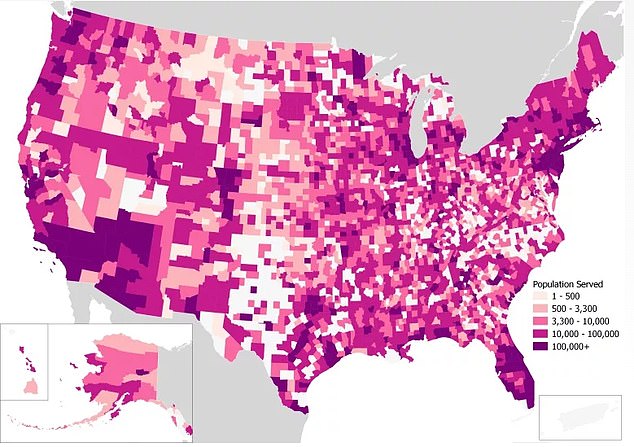The White House has pledged to replace all lead pipes in the next decade in an effort to curb the health effects related to drinking water contaminated with the toxic metal.
The Biden administration said the “historic” ruling could prevent the loss of up to 200,000 IQ points among children and reduce the number of babies born with low weight by one million.
Municipal utilities will need to replace almost all lead pipes that carry water in urban systems in the next 10 years. The EPA estimates that there are about 9 million lead pipes still in use nationwide.
It will reduce the allowable level of lead in metal pipes from 15 parts per billion to 10 parts per billion, although experts caution that there is no “safe” level of lead exposure.
The map above from the Natural Resources Defense Council (NRDC) shows the populations served by drinking water with the highest levels of lead contamination. Florida had highest concentration of lead pipes, independent study showed
Environmental Protection Agency (EPA) officials estimate the $30 billion initiative will protect nearly 1 million babies from lead poisoning, which has been shown to cause irreversible harm such as developmental problems, behavioral disorders and low birth weight.
However, the project’s high price tag has drawn criticism from utilities, which have cited supply chain issues and labor shortages as obstacles to timely pipe replacement.
said Dr. Mona Hanna, associate dean of public health at Michigan State University. The New York Times: ‘This norm is historical. It is a turning point.
“We have lived too long in the infrastructure of our great-grandparents.”
Lead water pipes have been used for decades, particularly in large cities during the late 19th century. By 1900, more than seven out of 10 American cities used them due to their durability.
However, when pipes begin to corrode, lead leaches into the water supply through faucets and tap water. Drinking water, showering, or even just washing dishes could lead to exposure.
Although the federal government banned lead pipes for new plumbing in 1986, the ban did not apply to older infrastructure, meaning millions of Americans could be drinking contaminated water.
Once consumed, lead can travel throughout the body through the blood and lodge in soft tissues such as the kidneys, liver or lungs, damaging these organs.
At higher doses, or with frequent exposure, it has been linked to behavioral problems, growth problems, and learning difficulties in children.
Additionally, the International Agency for Research on Cancer (IARC) has classified it as a probable carcinogen, meaning that high exposure will likely cause cancer, but there is no conclusive evidence yet.
Short-term exposure to lead can cause symptoms including headache, abdominal pain, vomiting, and anemia.
According to the CDC and FDA, there are no safe levels of lead exposure.

A ruling filed Tuesday by the Biden Administration will require all lead pipes (pictured here) in the U.S. to be replaced within the next 10 years.

The map above shows the number of service lines containing lead pipes per public water system. The Chicago Office of Water Supply had the most with 387,095, while Cleveland Water and the New York City System followed closely with 235,442 and 111,616, respectively.
September 2024 data from the nonprofit Natural Resources Defense Council analyzed the public water systems with the highest number of service lines that have lead pipes.
The data found that the Chicago Office of Water Supply had the most, with 387,095 service lines. Cleveland Water followed closely in second place with 235,442 lines of service, and the New York City System took third place with 111,616 lines.
The City of Detroit Water and Sewer System and Milwaukee Water Works rounded out the top five, with 79,617 and 74,099 lines, respectively.
It’s not clear exactly how many people these areas serve, but they could encompass the entire population of the cities. For the five main areas, this would add up to around 12.5 million people.
Of the top 30 sites listed in the data, the City of Rochester Water Office in upstate New York had the lowest number of service lines with lead pipes at 19,744.
Although the agency did not provide exact figures for each county, Alaska and Hawaii appeared to have the fewest service lines with lead pipes.
Tuesday’s new ruling updates the Safe Drinking Water Act of 1991, which required lead pipes to be replaced in areas where levels exceeded 15 parts per billion in at least 10 percent of the water sampled.
However, some cities with a particularly large number of lead pipes may be allowed more than 10 years to get rid of them. One draft rule, for example, gives Chicago up to 50 years. It’s unclear how much that timeline could be shortened in a final draft.


